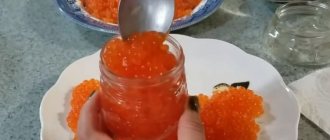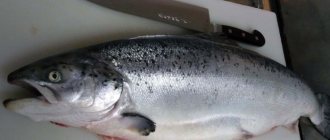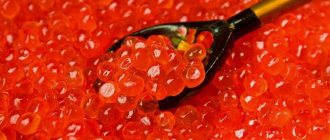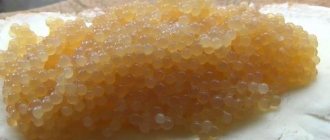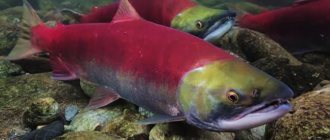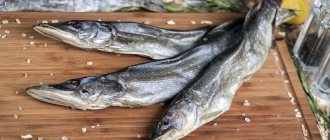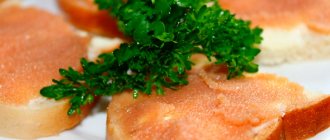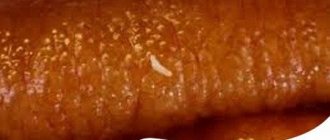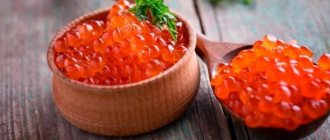Sima caviar
This is the rarest type of caviar, and the fish itself is an ancient species of Pacific salmon, or rather its warm-water representative. The eggs are red with an orange tint and reach about 6 mm in diameter.
They taste like sockeye salmon caviar, but without a hint of bitterness. Sima go to spawn in early summer. For sale to the population, it is prepared in rare cases, which explains the high price.
For a kilogram of product you will have to pay 5,000 rubles.
What are the differences between chum salmon and coho salmon caviar?
Coho salmon lay up to 7 thousand eggs in one go. Caviar is small in size, but its nutritional value is considered the highest among culinary specialists. The diameter of the eggs is no more than 4 mm, and the taste has an unusual bitterness. Along with this, the caviar has a striking, rich red color, in contrast to the caviar of other salmon species, the color of the caviar of which ranges from a slight red to a red-crimson hue.
Chum salmon caviar is enormous in size (5-9 mm) when compared with coho salmon caviar. Along with this, the eggs have the shape of balls of regular geometry with a clearly defined red dot in the center of each egg. The color of the eggs is characterized as orange-amber, and there is no bitterness in the taste.
Differences between tastes
Naturally, there is a difference, but the preference of one caviar over another depends on the personal taste preferences of the consumer.
Coho salmon caviar may differ in uneven color and the presence of bitterness. Despite this, coho salmon caviar is considered quite tasty and necessary.
Chum salmon caviar is characterized by the presence of a strongly pronounced taste. Despite this, it is not particularly popular among the population due to the hard shell surrounding each egg.
Properties of caviar
Coho salmon caviar is much more nutritious than the caviar of other salmon species, but its industrial value is not as high when compared with chinook or pink salmon caviar.
Chum salmon caviar is distinguished by its enormous protein content, which is easily absorbed by the human body.
Many experts and nutritionists advise systematically using caviar from different types of fish, at least 6-8 times every thirty days.
Calorie content of caviar
100 grams of chum salmon caviar contains more than 300 kcal, and coho salmon caviar – 150 kcal . This suggests that chum salmon caviar has more calories. Coho salmon caviar contains from 6.1 to 9.5% fat. Therefore, we can safely assume that coho salmon caviar is more suitable for dietary nutrition.
Harm and benefits of caviar
The presence of many necessary substances in the caviar of salmon fish species promotes rejuvenation of the body, helps to cope with male impotence, feel a surge of vital energy, and strengthen the immune system. The presence of iodine in caviar helps combat poor functioning of the internal secretion organs.
Despite the many positive effects in the case of consumption of red caviar, it is better to reduce its consumption for people who have undergone surgery, for people suffering from rickets, of course, in conditions when the human body is very weakened. Coho salmon caviar is not recommended for use by pregnant women, people suffering from poor functioning of the digestive system, of course, in cases of liver dysfunction.
Price – is it worth paying more?
Due to the fact that most salmon species, as well as coho salmon, are caught at a tremendous rate due to their nutritional value, the price of caviar from these fish is high. Chum salmon caviar is in great demand in restaurant chains, of course in another area of public catering. In general, the price of chum salmon and coho salmon caviar is actually the same on the market and is about 300 rubles per 130 grams.
How to choose red caviar
When choosing this delicious product, pay attention to the following nuances:
- It is better to choose a product packaged in glass containers, but not in cans, because there is no way to determine the quality of the product without breaking the packaging.
- A high-quality product has grains of the correct geometric shape that do not stick together.
- If the color of the eggs corresponds to a red-crimson hue, not counting Chinook salmon caviar, then this indicates a fake.
- Caviar packaged in tin cans can be a product containing an increased amount of liquid, with grains of irregular shape, and of course with the presence of preservatives.
- The shelf life of the packaged product is no more than six months, which must be indicated on the label.
- Caviar can correspond to both the first grade, while the salt concentration is no more than 6%, and of course the second grade, with a salt concentration of up to 8%. First grade caviar must have whole eggs, without the presence of blood and without the presence of parts of the egg, as indicated in the technical specifications.
Also, each variety has special requirements for the smell, which must be attractive and not contain any other odors, and of course, the homogeneity of the product.
Chinook caviar
Chinook salmon is the largest representative of the Salmonidae family. Its eggs are also among the largest - up to 7-10 mm in diameter. The bright red caviar of king salmon tastes like beetle caviar. It still has the same bitterness and spiciness, but it is a most delicate delicacy. The shell of the eggs is not as hard as that of chum salmon.
The price for Chinook salmon caviar is one of the highest, since it is practically not found on the domestic market. In Russia, king salmon is caught only in Kamchatka.
When purchasing a product, be sure to find out the region of the manufacturer. In the central part of the country, you can find a lot of counterfeit Chinook caviar in stores. Usually the counterfeit product is made from chum salmon caviar with the addition of dye.
1 kg of delicacy will cost approximately 4,500 rubles.
How not to oversalt caviar when salting
When salting caviar, you should first determine the shelf life of the product. If there is not much caviar, then you can prepare a lightly salted version, then the shelf life will be no more than 2 days. For longer preservation, more salt should be added. Salt acts as a preservative, so for long-term preservation, it is necessary to saturate the eggs with salt for a long time.
If, during salting, you overdid it with salt and the caviar did not turn out to your taste, the problem can be corrected. The over-salted product should be poured with fresh cooled infusion of regular tea and left for 10 minutes. Then put the caviar on a sieve, dry it, put it in a jar and pour in a little refined oil.
For lovers of lightly salted red caviar, we offer a simple salting recipe.
Recipe for lightly salted pink salmon caviar
Chum salmon caviar
It is large - reaches 5-7 mm in diameter, but there are specimens up to 9 mm in size. It has a uniform pale red color with an orange tint. Inconsistency in color is considered a defect and is not allowed during the production process, otherwise the product is considered defective.
Chum salmon caviar is the fattest delicacy. Its taste is soft, delicately creamy, without bitterness. The shell is very thin and breaks quickly, so it feels like it melts in your mouth. This product is considered the best of all types of salmon caviar. It is often passed off as Chinook salmon caviar due to its large size, but it should be remembered that chum salmon caviar is the lightest of all varieties.
The average cost of 1 kg is 4,200 rubles.
Differences between caviar of different fish
Red caviar comes in only two varieties:
- 1st grade - packaging of one type without foreign odors and additives. All eggs are easily separated from each other and have the same color and size. The salt content does not exceed 4%.
- Grade 2 allows for mixing caviar from different representatives of salmon. According to GOST standards, a small content of impurities is allowed in the form of oyster - the shell in which the eggs of the caught fish are located. The salt content can reach up to 8%.
So what kind of red caviar is there and what are the differences between each type? Today, for the industrial production of red caviar, there are mainly six representatives of salmon, whose caviar differs in size and taste.
This type of caviar is most often found on sale. It has a universal taste, familiar to everyone, a bright orange color and medium-sized eggs with a thin shell. Large pink salmon eggs are evidence of a low quality product. This is overripe caviar with a dense shell.
Thanks to the artificial breeding of this salmon species, trout caviar is also quite common and is not considered in short supply. Trout eggs are small and often look stuck together, so they are often used to decorate canapés and sandwiches. Color varies from dark yellow to purple. There is a noticeable bitterness in the taste.
It is considered a delicacy and is rightfully one of the standards of taste for this granular product. Chum salmon eggs are large in size, have a rich light orange color and a delicate creamy taste. A distinctive feature of chum salmon caviar is the melting effect in the mouth, due to the thin shell that bursts when lightly pressed with the tongue. The taste is universal, without bitterness or fishy smell.
This granular product will be appreciated by a true connoisseur due to its rather rich, spicy taste with a very noticeable bitterness. The eggs are small, similar in appearance to trout eggs, however, they have a richer red color.
Coho salmon or silver salmon caviar has a fairly fine structure and a bitter taste, most often dark red. However, due to the high content of vitamins and minerals, coho salmon caviar is considered the most useful. However, coho salmon is not caught on an industrial scale, as it is small in number and is considered a valuable fish.
Chinook caviar
Chinook salmon, or king salmon, is the largest and rarest representative of this family of fish. The Chinook salmon catch in Russia is very limited, which further increases its value. Chinook caviar is large in size and has a delicate taste with a barely noticeable bitterness. The structure of the caviar is homogeneous, the eggs are not stuck together and are easily separated from each other.
The most famous and beloved varieties of salmon delicacies are red caviar from chum salmon, pink salmon, sockeye salmon and coho salmon. Each of them has a number of its own characteristics - size, taste, value. Having looked at this in more detail, you can see what their differences are.
Chum salmon caviar
The eggs of this species are large in size. They resemble regular-shaped balls with a diameter of up to 7 mm. The color is orange, usually uniform. The shell is strong. It takes effort to break it, so the product retains its shape for a long time. Chum salmon caviar is distinguished by its delicate taste. There may be a slight bitterness, which does not spoil its taste at all.
Coho salmon caviar
Coho salmon or “silver” salmon is a small representative of the salmon family. Its caviar is considered a powerful aphrodisiac. It increases the level of serotonin and endorphin (“the hormone of joy”).
The size of the beads is not as large as in previous types, reaching only 4 mm. Caviar is easily recognized by its dark red color with a burgundy tint. During the production of the product, heterogeneity in color is allowed.
The taste of this caviar is unique and suggests a slight bitterness, but in terms of the content of microelements and vitamins it occupies a leading place among its analogues.
For 1 kg of silver salmon caviar you will have to pay 4,200 rubles.
Granular salmon caviar (pink salmon) “Makarov”
Cost 420 rub. Net weight 140 g. First grade. GOST 18173–2004
Manufacturer: Kamchatka Fish and Food Products Plant LLC. Packaged by RK Sardinia LLC, Moscow region, Lyubertsy district. Ingredients: caviar, salt, vegetable oil, preservatives E200, E211.
The caviar has a good color. There is practically no liquid. Salt content at the upper limit. There are practically no skins, just a few. Not bitter, the aftertaste is pleasant. In this caviar the quality matches the price.
As the expert noted, good pink salmon caviar should not cost less than 370-450 rubles. for 100 g.
One of the advantages of the packaging is a plastic lid that can be used to close the jar after it has been opened. Although it is better to transfer the caviar into a glass or plastic container after opening the jar.
Trout caviar
This is the smallest red caviar - the size of the eggs does not exceed 2-3 mm. It comes in different colors - from yellow to red. The coloring depends on the time and place where the females were caught.
The taste of the delicacy is bitter, with a noticeable fishy aftertaste. The eggs are quite sticky and salty. They are often served on canapés and sandwiches.
The average cost of 1 kg of trout eggs is 3,600 rubles.
Granular salmon caviar (pink salmon)
Cost 178 rub. Net weight 95 g. First grade. TU 10.20.26-001-05502137-2017
Made from frozen raw materials.
Manufacturer "RKZ 24" Vladimir region, Kirzhach. Place where raw materials were caught - Kamchatka Territory Ingredients: granular caviar of the salmon family (pink salmon), salt, vegetable oil, preservative E200, E211.
Everything about this caviar was broken. A large amount of liquid, caviar of different colors. This caviar turned out to be even saltier than the first sample. Bitter aftertaste, a sign that a lot of preservatives have been added. The grain is almost all crushed, you can feel the skin, and the skin is of unknown origin.
Sockeye salmon caviar
Sockeye salmon mainly lives along the American coast, so it is rarely found in Russian stores. The size of the eggs is most often no more than 3 mm, but can reach 5 mm. They have a rich dark orange color and a strongly noticeable odor.
In production, uneven coloring is not considered a defect, since various shades of red-orange tones may be present. However, if the product contains white or black color, this indicates that it is spoiled. The taste has piquancy and a slight bitterness, which is not typical for the caviar of the next rated fish.
The average cost of 1 kg of sockeye salmon caviar is 3,200 rubles.
How to choose pink salmon with caviar
We found a female pink salmon, but this does not mean that she has eggs. All that remains is to identify the female with the eggs:
- Select several female carcasses and compare them with each other.
- Press lightly on the abdomen. If you feel a lump, there is most likely caviar in the fish.
- Carefully inspect the hole for the release of eggs; in the female with eggs it is pink and slightly larger in size than in other fish.
There is no 100% way to identify pink salmon with caviar. You can talk to the seller, if he is experienced, he will be able to tell you how to make the right choice and buy fish with caviar.
Pink salmon caviar
Most often, this caviar of fish of the Salmonidae family is found on store shelves, the price of which is slightly lower than for previous varieties.
The fish move to spawn from June to August. The trajectory of its movement is from the North Pacific Ocean to the adjacent rivers. The experience of fishermen shows that fish numbers fluctuate between even and odd years. The lifespan of the humpback is up to 2 years. It spawns once in its life, after which it dies.
The size of pink salmon eggs varies from 3 to 5 mm. Most often they are bright orange in color. After tasting them, one can note the absence of bitterness, but the presence of slight saltiness.
The average cost of pink caviar is 3,200 rubles per 1 kg.
Expensive types of red caviar are a real delicacy with a pleasant aftertaste. A quality product must have a number of characteristics. In particular, the eggs in the jar should be the same size and color, whole, uncrumpled, crumbly, without mucus, films or plaque.
Choosing a female pink salmon
Following our advice with photo comparisons of females and males, making the right choice is easy.
Pink salmon are caught during spawning; the fish spawns at the end of August. And therefore, it is easiest to buy pink salmon with caviar during this period. The rest of the time, frozen fish is sold in stores. In a frozen state, use all the tips to distinguish a female from a male:
- The male is primarily a predator and therefore differs in size and more predatory appearance. This is especially true for the jaw. Look at the photographs, the male's jaw has characteristic curves, the teeth are curved and larger. The female has a straight jaw, her teeth are almost invisible.
Pay attention to the jaws. The male (above) has obvious curvatures of the upper and lower jaw. The female (bottom) has a straight jaw.
Female on top, male below. Note the differences in the jaws. - Differences in color. Males are brighter and more colorful. This is how nature works in order to attract the attention of predators and protect females; males are always brighter and more beautiful.
Male pink salmon on top, female on bottom. - The difference for which this fish received its name is the hump. The male, during and after spawning, gains a visible hump on his back.
The male is from below, with a pronounced hump on the back.
These points are usually enough to correctly select a female pink salmon.
Take a look at the head of the fish: if you see scary, sharp teeth and curved jaws, this is a male.
